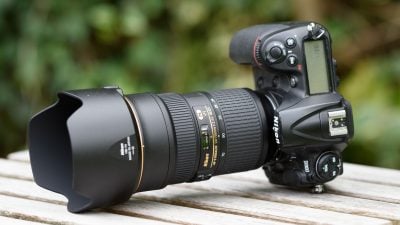Nikon 24-70mm f2.8E VR review
-
-
Written by Thomas
Quality
Longitudinal Chromatic Aberration and focus shift
With lenses offering an aperture of f2.8 or larger I test for longitudinal CA (loCA, a.k.a. “axial color” or “bokeh CA”). The new Nikon shows a pretty weak magenta coloration in the foreground (left) and greenish hues in the background (right). There’s nothing to worry about.
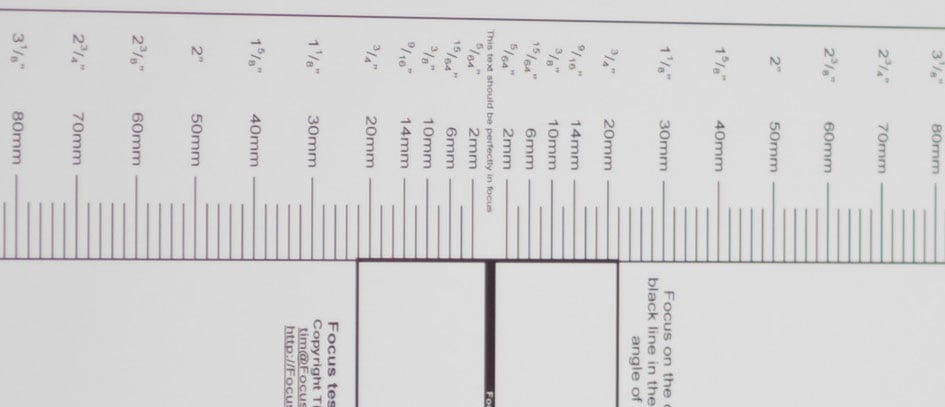
Sharpness and contrast
Let’s have a look at the theoretical performance of the new lens first compared to the performance of the Nikon 24-70/2.8G:
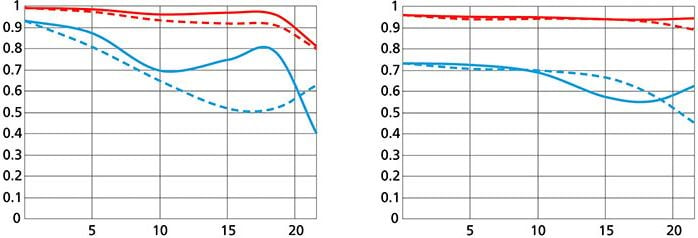
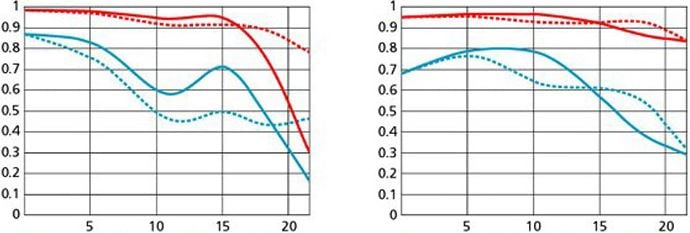
These charts show the lens-performance at the largest aperture. Higher values are better and the closer the dotted and the continuous lines of each color are together the less astigmatism (= resolution depends on the orientation of the test-pattern) the lens has. The x-axis displays the distance from the optical axis (=center of the sensor) in mm. I’ll show you the real-life performance at 4 mm (center), 13 mm (DX-corner), and 20 mm (FX-corner) on a D810.
From the charts, the new lens looks clearly better at the wide end than its predecessor. At 70mm the story is a bit different: In overall contrast both lenses look similar, but the old lens has an advantage between 4mm and 11mm off the optical axis, while the new zoom is better outside the DX image-circle (15-21mm). But let’s see how this theoretical performance translates into real life results in the sharpness test based on Siemens-stars.
What follows are near-center results (first column) followed by DX-corner results and FX-corner results on a D810. The D810 results from the DX-corner should be a very good approximation for performance on a 16MP DX sensor (like the D7000), because the pixel-pitch of both sensors are the same. But differences in the AA-filter and micro-lens-design of a D810 and a D7000 might yield different end-results.
Processing was done in Lightroom 5.7.1 from RAW at Camera Standard settings. Noise-reduction is set to 0, sharpening to 35/0.5/36/10, with no extra tone, color, or saturation-adjustment. White-balance was adjusted to a neutral white and I did some exposure compensation to make the brightness match. CA-removal is ON.
The following are all 100% crops!
Let’s have a look at the performance at 24mm focal length first:
Nikon 24-70/2.8E ED VR on a D810; 100% crop from center, DX-corner, FX-corner

Above: 24mm, f2.8

Above: 24mm, f4.0

Above: 24mm, f5.6

Above: 24mm, f8.0

Above: 24mm, f11

Above: 24mm, f16
Performance at 28mm:
Nikon 24-70/2.8E ED VR on a D810; 100% crop from center, DX-corner, FX-corner

Above: 28mm, f2.8

Above: 28mm, f4.0

Above: 28mm, f5.6

Above: 28mm, f8.0

Above: 28mm, f11

Above: 28mm, f16
Performance at 35mm:
Nikon 24-70/2.8E ED VR on a D810; 100% crop from center, DX-corner, FX-corner

Above: 35mm, f2.8

Above: 35mm, f4.0

Above: 35mm, f5.6

Above: 35mm, f8.0

Above: 35mm, f11

Above: 35mm, f16
Performance at 50mm:
Nikon 24-70/2.8E ED VR on a D810; 100% crop from center, DX-corner, FX-corner

Above: 50mm, f2.8

Above: 50mm, f4.0

Above: 50mm, f5.6

Above: 50mm, f8.0

Above: 50mm, f11

Above: 50mm, f16
Finally performance at 70mm:
Nikon 24-70/2.8E ED VR on a D810; 100% crop from center, DX-corner, FX-corner

Above: 70mm, f2.8

Above: 70mm, f4.0

Above: 70mm, f5.6

Above: 70mm, f8.0

Above: 70mm, f11

Above: 70mm, f16
These 100% crops directly from a 36MP D810 sensor show that this lens delivers a very good performance at the center right from the start except for 50mm focal length which looks a bit soft. At the border of the DX image-circle performance is good at f2.8 with 50mm again being the weak(est) focal length. And the FX-corner is pretty good for a full-frame zoom with 35mm being the softest. Overall performance degrades gracefully towards the corners of a full-frame sensor and at f5.6 the lens produces a very satisfying performance across the frame and the focal range. Only at 35mm there seems to be a weakness where even stopping down does not produce exactly clean and sharp FX-corners. The effect of diffraction can be seen from f11 onwards. Distortions are lowest around 28mm focal length. Below that the lens produces very visible barrel distortions. And at longer focal lengths the pin-cushion distortion becomes pretty prominent.
Comparison with other lenses
Following is the performance of the Nikon 24-70/2.8E VR at f2.8 directly compared to the Nikon 24-70/2.8G and the Tamron SP 24-70/2.8 VC at f2.8 and various focal lengths. Starting at 24mm:

Above: Nikon 24-70/2.8E ED VR on a D810 at 24mm, f2.8, 64 ISO

Above: Nikon 24-70/2.8G ED on a D800 at 24mm, f2.8, 100 ISO

Above: Tamron SP 24-70/2.8 VC on a D800 at 24mm, f2.8, 100 ISO
Comparison at 35mm:

Above: Nikon 24-70/2.8E ED VR on a D810 at 35mm, f2.8, 64 ISO

Above: Nikon 24-70/2.8G ED on a D800 at 35mm, f2.8, 100 ISO

Above: Tamron SP 24-70/2.8 VC on a D800 at 35mm, f2.8, 100 ISO
Comparison at 50mm:

Above: Nikon 24-70/2.8E ED VR on a D810 at 50mm, f2.8, 64 ISO

Above: Nikon 24-70/2.8G ED on a D800 at 50mm, f2.8, 100 ISO

Above: Tamron SP 24-70/2.8 VC on a D800 at 50mm, f2.8, 100 ISO
Comparison at 70mm:

Above: Nikon 24-70/2.8E ED VR on a D810 at 70mm, f2.8, 64 ISO

Above: Nikon 24-70/2.8G ED on a D800 at 70mm, f2.8, 100 ISO

Above: Tamron SP 24-70/2.8 VC on a D800 at 70mm, f2.8, 100 ISO
When compared to its predecessor and its main competitor the new lens shows the best FX-corner of the bunch. And at the shorter focal lengths by a large margin! In the center the new lens sometimes lags a bit behind its competition in sharpness. And the border of the DX image-circle is a pretty mixed competition. What you cannot see in the above comparisons: Compared to its predecessor the new 24-70mm zoom has clearly less field-curvature.
Performance at long distances
The Siemens-star test-targets are shot at a distance of 40x focal length (i.e. at 2m for 50mm focal length). But performance of lenses also depends on the shooting distance. Therefore I present another series of test-shots of a landscape dubbed the “Unremarkables” where you can measure distances in km, not meter. Processing was done in Lightroom 5.7.1 from RAW at Adobe Standard settings. Noise-reduction is set to 0, sharpening to 35/0.5/36/10, with no extra tone, or saturation-adjustment. There’s no tinkering with vignette-control so you see it here as it is produced by the lens. Focus was acquired at the largest aperture manually and not changed for other apertures.
You can click on each image to access the large original. Please respect our copyright and only use those images for personal use.
The main image shows the complete scene at f2.8 to give you an impression of the angle of view and to judge vignetting. You can access the respective shots up to f16 via the links beneath the main image. All shots were made at ISO 64 and VR switched off. Following the main image are 100% crops from the center, the DX-corner and the FX-corner from the new Nikon and its predecessor at f2.8 to compare performance and then from the new lens at f4.0 down to f11.
Let’s start with 24mm focal length:
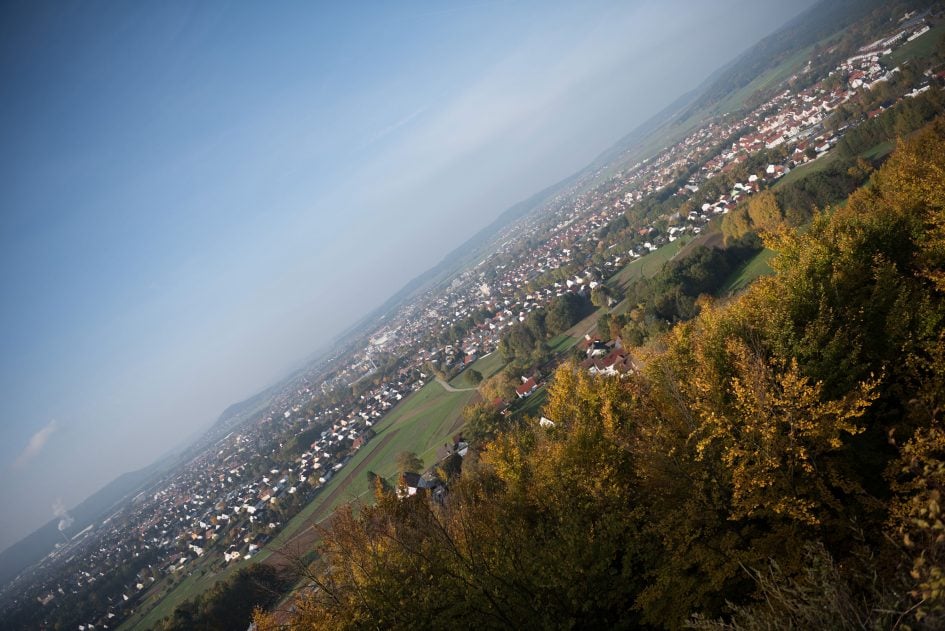
Above: Nikon 24-70/2.8E VR on a D810 at 24mm, f2.8, 64 ISO; also available at f4.0, f5.6, f8.0, f11, f16

Above: Nikon 24-70/2.8E VR at 24mm, f2.8

Above: Nikon 24-70/2.8G at 24mm, f2.8
While both lenses look the same in the center- and DX-crop the improvement in FX-corner performance of the new 24-70/2.8E VR is glaringly obvious. Very good!

Above: Nikon 24-70/2.8E VR at 24mm, f4.0

Above: Nikon 24-70/2.8E VR at 24mm, f5.6

Above: Nikon 24-70/2.8E VR at 24mm, f8.0

Above: Nikon 24-70/2.8E VR at 24mm, f11
Stopping down does reduce vignetting but otherwise has no great impact on image quality: The DX-corner stays somewhat soft. And beyond f5.6 the excellent center loses some of its crispness. On another note: The lens shows a slight tendency of becoming brighter and brighter in the center when stopping down. It’s not much (perhaps 0.1 EV per stop) but if you compare brightness of the center-crops at f2.8 or f4.0 with that of f11 it is clearly visible.
Results at 28mm:
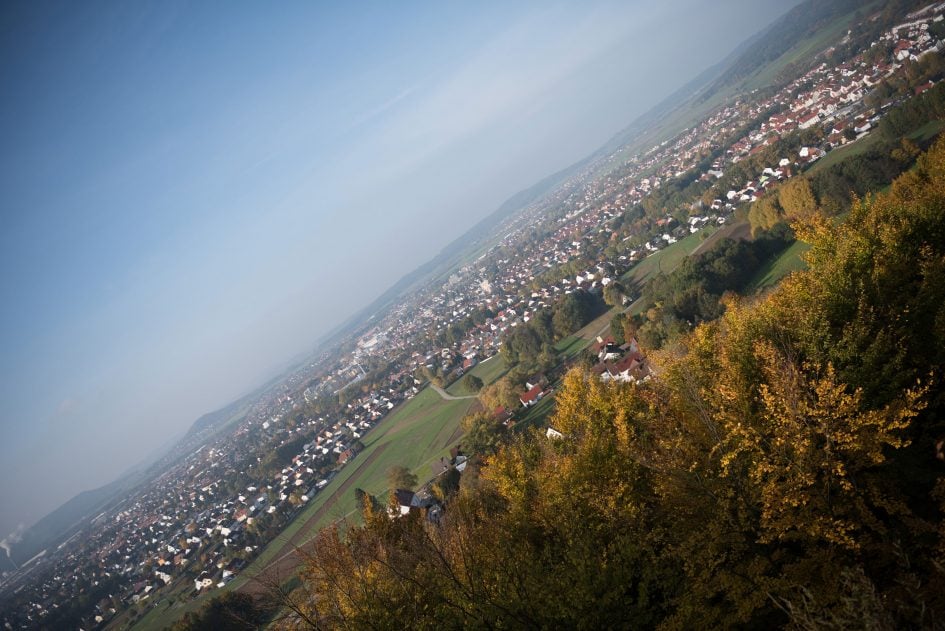
Above: Nikon 24-70/2.8E VR on a D810 at 28mm, f2.8, 64 ISO; also available at f4.0, f5.6, f8.0, f11, f16

Above: Nikon 24-70/2.8E VR at 28mm, f2.8

Above: Nikon 24-70/2.8G at 28mm, f2.8
At 28mm the improvement in FX-corner sharpness becomes even more obvious. And this time the DX-corner of the new zoom looks better than with its predecessor.

Above: Nikon 24-70/2.8E VR at 28mm, f4.0

Above: Nikon 24-70/2.8E VR at 28mm, f5.6

Above: Nikon 24-70/2.8E VR at 28mm, f8.0

Above: Nikon 24-70/2.8E VR at 28mm, f11
Stopping down again does improve little except for vignetting. F11 and beyond should clearly be avoided for sharpest results.
Results at 35mm:
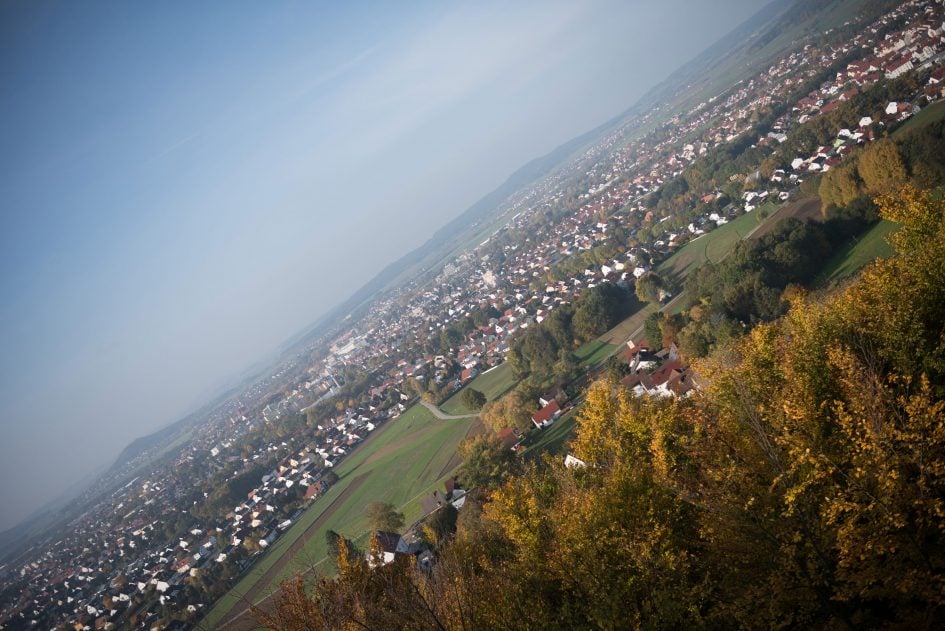
Above: Nikon 24-70/2.8E VR on a D810 at 35mm, f2.8, 64 ISO; also available at f4.0, f5.6, f8.0, f11, f16

Above: Nikon 24-70/2.8E VR at 35mm, f2.8

Above: Nikon 24-70/2.8G at 35mm, f2.8
Similar performance as at 28mm: Again the new lens has a slight lead at the DX-corner and a big advantage in the FX-corner.

Above: Nikon 24-70/2.8E VR at 35mm, f4.0

Above: Nikon 24-70/2.8E VR at 35mm, f5.6

Above: Nikon 24-70/2.8E VR at 35mm, f8.0

Above: Nikon 24-70/2.8E VR at 35mm, f11
The center is so sharp that you can see the slight degradation of sharpness when stopping down from f5.6 to f8. Even more so at f11.
Results at 50mm:
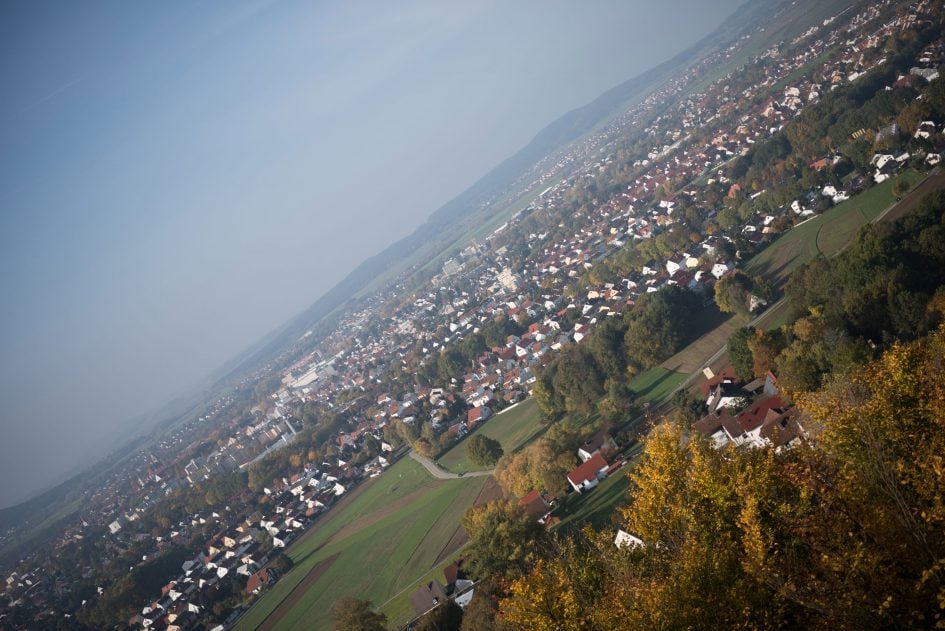
Above: Nikon 24-70/2.8E VR on a D810 at 50mm, f2.8, 64 ISO; also available at f4.0, f5.6, f8.0, f11, f16

Above: Nikon 24-70/2.8E VR at 50mm, f2.8

Above: Nikon 24-70/2.8G at 50mm, f2.8
At 50mm the 24-70/2.8E VR looks just a tad softer in the center than its predecessor. DX-corner is a bit mushy but still a little better than the 24-70/2.8G. And the clear lead of the new lens in the FX-corner continues.

Above: Nikon 24-70/2.8E VR at 50mm, f4.0

Above: Nikon 24-70/2.8E VR at 50mm, f5.6

Above: Nikon 24-70/2.8E VR at 50mm, f8.0

Above: Nikon 24-70/2.8E VR at 50mm, f11
The DX-corner needs stopping down to f5.6 to sharpen up nicely.
Results at 70mm:
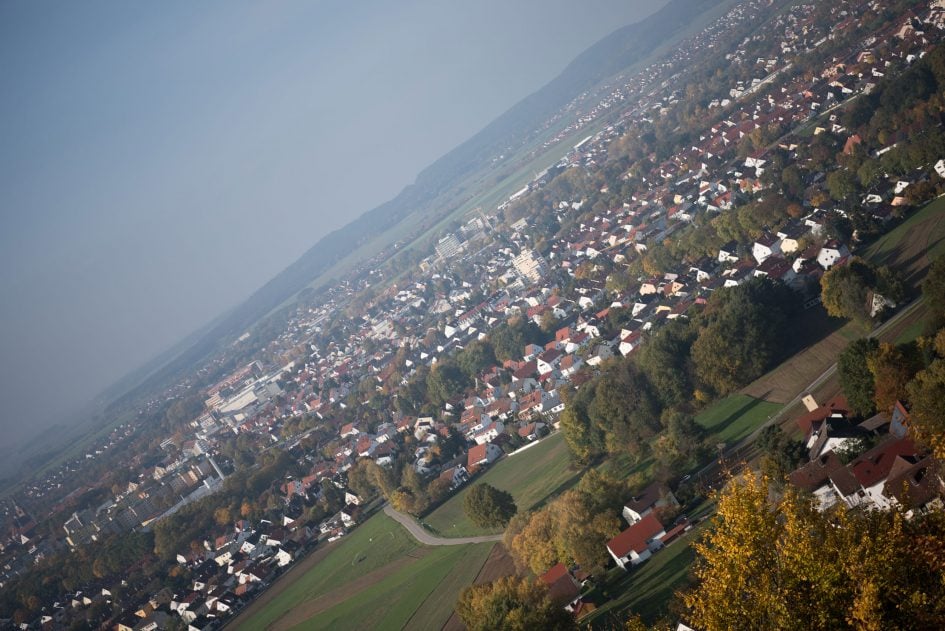
Above: Nikon 24-70/2.8E VR on a D810 at 70mm, f2.8, 64 ISO; also available at f4.0, f5.6, f8.0, f11, f16

Above: Nikon 24-70/2.8E VR at 70mm, f2.8

Above: Nikon 24-70/2.8G at 70mm, f2.8
At 70mm the “old” zoom performs a bit better in the center than the new lens. But in the DX-corner the new lens pulls ahead. In the FX-corner the predecessor has closed the gap to the new zoom considerably albeit still lags behind.

Above: Nikon 24-70/2.8E VR at 70mm, f4.0

Above: Nikon 24-70/2.8E VR at 70mm, f5.6

Above: Nikon 24-70/2.8E VR at 70mm, f8.0

Above: Nikon 24-70/2.8E VR at 70mm, f11
Stopping down to f4 and doubling the exposure time makes the center about 0.25 EV brighter (both shots are only 5 seconds apart). A peculiarity that I also observed with my Siemens-star test-shots where I had to reduce center brightness of the f4.0 shot by about 0.3 EV to make it match. When you stop down to f5.6 the new lens produces very good DX-corners and gets rid of the vignette in the FX-corner.
The tested copy is a bit decentered so performance in the different quadrants of the image varies. But from the analysis of the section from the center to the upper right corner you can see that this lens can perform quite impressive. The FX-corner performance of the new lens shows a marked improvement over its predecessor at all focal lengths – although I would trade some of the FX-corner sharpness for a better performance around the DX-corner at f2.8. Vignetting is pretty strong (and stronger than with the predecessor), not only at short focal lengths.
The tests at long distances confirms the findings of the Siemens-star test-shots: All-in-all the lens delivers good to very good resolution across the full-frame sensor – if it were well centered. And it surpasses its predecessor clearly in the FX-corner.
Vignetting
To make it easier to compare light fall-off in the corners of a full-frame sensor I’ve arranged a series of four shots each with the new lens (1st row) and its predecessor (2nd row) at f2.8 and different focal lengths: from left to right: 24mm, 35mm, 50mm, and 70mm:
Vignetting: Nikon 24-70/2.8E ED VR (1st row) vs. Nikon 24-70/2.8G (2nd row)
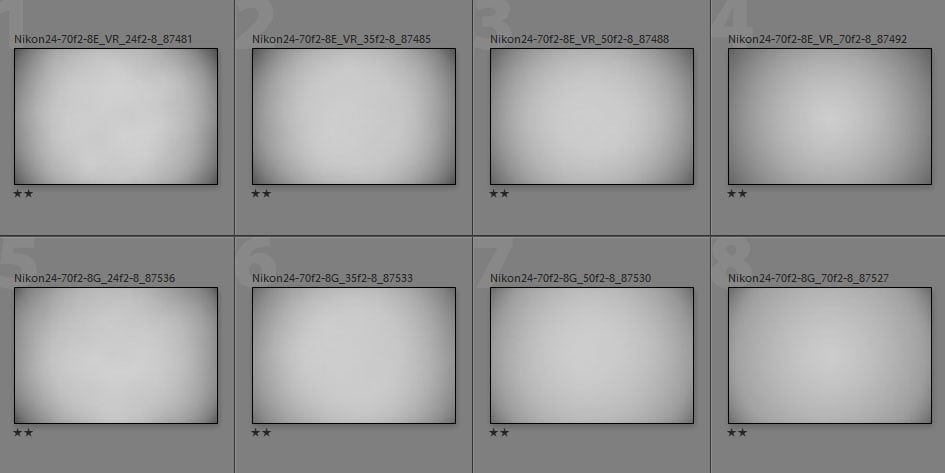
from left to right: 24/2.8, 35/2.8, 50/2.8, 70/2.8
It is obvious that the new lens has stronger vignetting than its predecessor. And although vignetting is greatly reduced by stopping down it is still visible with the new lens at f5.6 (not shown here).
Rendering of point-light sources at night-shots
Night-shots pose a different challenge for lenses as the contrast is even higher than under bright sun and point-light sources can reveal some weaknesses such as coma, haloing and color-aberrations that do not show up as prominently in other test-shots. The 100% crops below the main image show the effect of coma in the FX corner of this lens at various apertures and focal lengths. It turns out that coma is pretty well controlled in this lens which is part its good FX-corner performance:
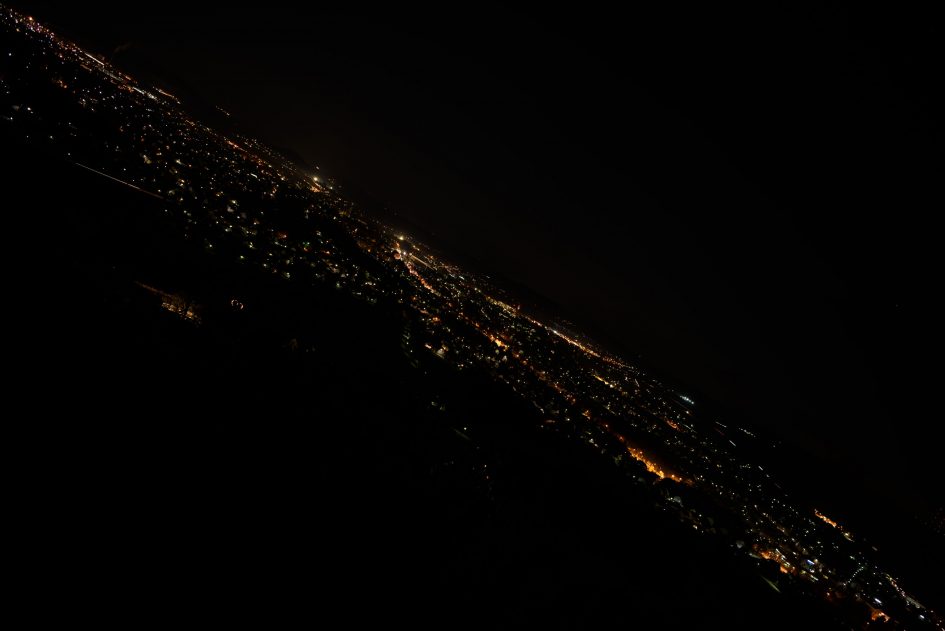
Above: Nikon 24-70/2.8E ED VR on a D810 at 24mm, f2.8

Above: FX corner at 24mm, f2.8; 24mm, f4.0; 24mm, f5.6

Above: FX corner at 35mm, f2.8; 35mm, f4.0; 35mm, f5.6

Above: FX corner at 50mm, f2.8; 50mm, f4.0; 50mm, f5.6

Above: FX corner at 70mm, f2.8; 70mm, f4.0; 70mm, f5.6
Compared to the Nikon 24-70/2.8G at 24mm and 35mm:

Above: Nikon 24-70/2.8G ED FX corner at 24mm, f2.8; 24mm, f4.0; 24mm, f5.6

Above: Nikon 24-70/2.8G ED FX corner at 35mm, f2.8; 35mm, f4.0; 35mm, f5.6
Also available 50/2.8, 50/4.0, 50/5.6, and 70/2.8, 70/4.0, 70/f5.6.
The new lens clearly bests its predecessor in this test showing much better controlled coma.
Rendering of out-of-focus point-light sources
This test is for the rendering of point-light sources in an out-of-focus background. The circle of confusion that is produced by this test is pretty indicative of Bokeh performance (in the background) and light fall-off. Ideally the out-of-focus image of the point-light is evenly lit and perfectly circular, with no “onion-rings”, and without coloration. Large aperture lenses normally produce an effect known as “cat’s eye” the further away from the optical axis the point-light is projected. This is due to optical vignetting in the lens barrel when light enters the lens from an angle.
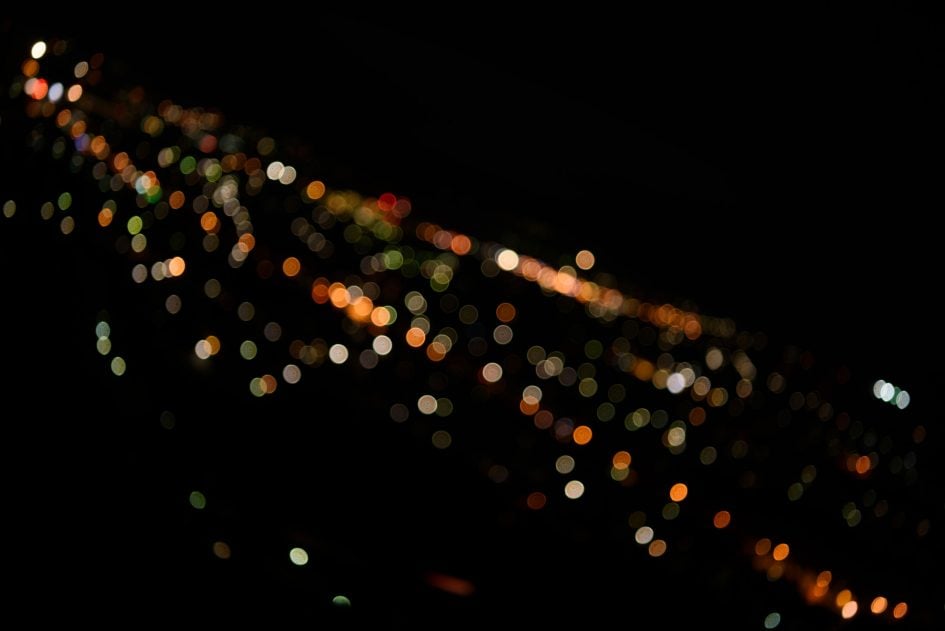
Above: Nikon 24-70/2.8E ED VR on a D810 at 70mm, f2.8; also available at f4.0, f5.6, f8.0

Above: Nikon 24-70/2.8E ED VR at 70mm, f2.8; 50% crops from center, DX-corner, FX-corner
And compared to the Nikon 24-70/2.8G:

Above: Nikon 24-70/2.8G ED at 70mm, f2.8; 50% crops from center, DX-corner, FX-corner
Also available at 70/4.0, 70/5.6, 70/8.0.
As the 50% crops above show: The Nikon 24-70/2.8E VR produces a slightly smaller circle of confusion than its predecessor. It also exhibits a bit stronger onion rings from its aspherical elements and a brighter outline in the center than the 24-70/2.8G. The cat’s-eye effect towards the borders/corners of the sensor is also stronger than with the predecessor which is in line with the stronger vignetting. There is no clipping from the mirror-box.
Now let’s see how this analysis of out-of-focus point-light sources translates into Bokeh-performance shooting a book-shelf.
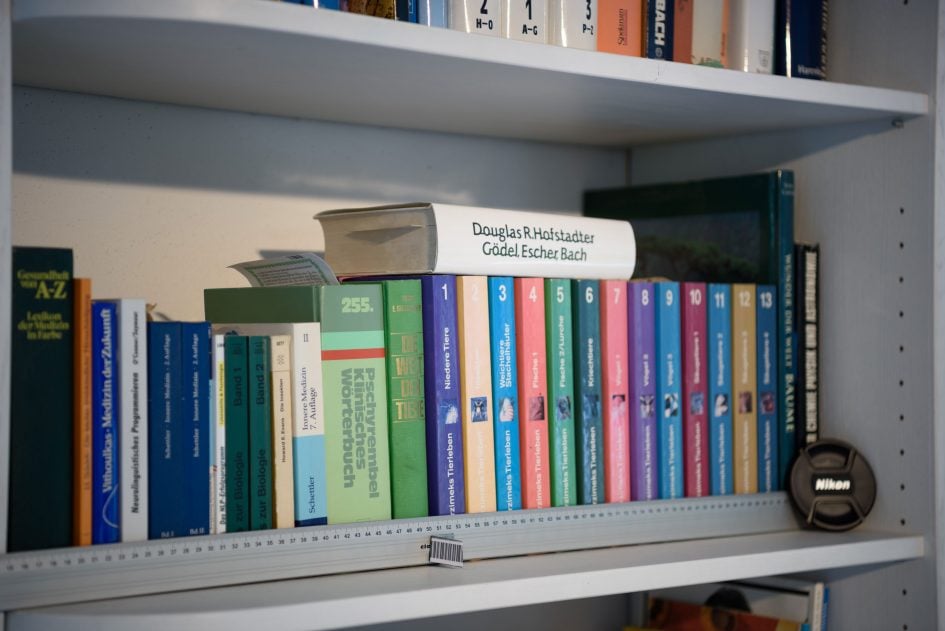
Above: Nikon 24-70/2.8E ED VR on a D810 at 70mm, f2.8; also available at f4.0, f5.6, f8.0

Above: Nikon 24-70/2.8E ED VR at 70mm, f2.8; 50% crops from foreground, middle-ground, background
And compared to the Nikon 24-70/2.8G:

Above: Nikon 24-70/2.8G ED at 70mm, f2.8; 50% crops from foreground, middle-ground, background
Also available at 70/4.0, 70/5.6, 70/8.0.
The (less important) foreground is a bit smoother than on the predecessor. The middle ground suffers from slight longitudinal CA coloring the black letters green. The background shows outlining on both lenses which makes the Bokeh nervous.
Flare/ghosting
Catching a strong light-source shining directly into the lens is a real risk with wide-angle lenses – even with the lens-hood attached. That could produce strange colorful ghosts-images or reduce contrast considerably through flare and glare. The appearance of flare and ghosting depends on factors like the aperture and the angle of the light hitting the lens. So to judge the proclivity of the Nikon for these artifacts I went through a series of almost 80 well calculated shots against a strong light source to provoke glare and ghosting.
The results are pretty good: As long as the light was clearly outside the image-frame (but still shining directly into the lens) I found only weak artifacts. When the light was near the image corner but still outside the frame it provoked a flare:
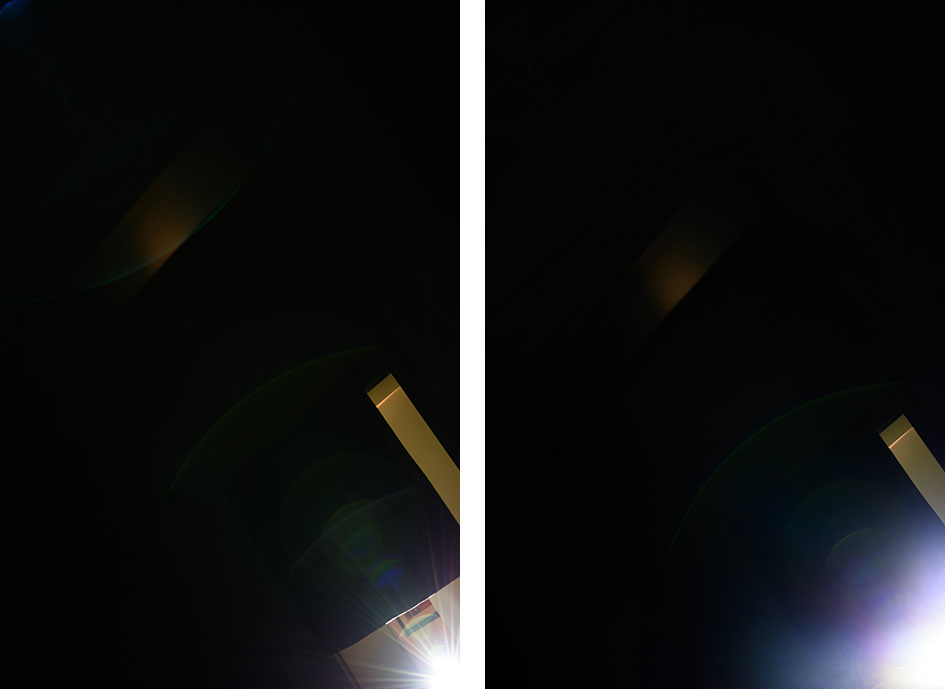
Above: Flare/ghosting. Light hitting the Nikon 24-70/2.8E ED VR at 70mm, f8.0 from inside the image frame (left); from outside the image frame (right)
So you have to watch out a bit for strong light-sources directly outside the frame. But other than that the flare-resistance of this lens is good. The following image shows the amount of ghosting that you can provoke:
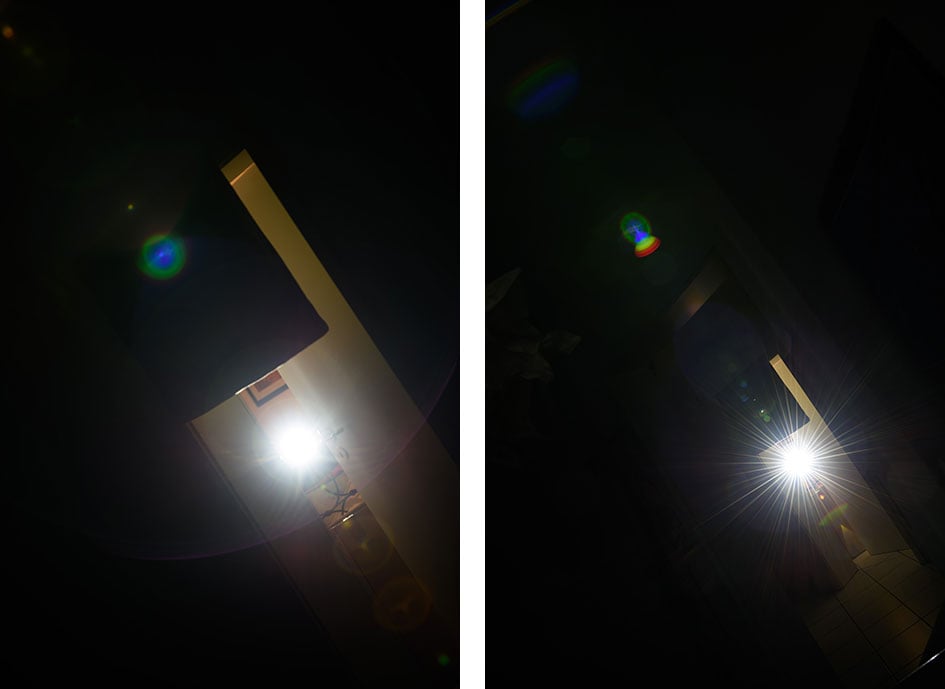
Above: Ghosting. A strong light source inside the image frame of the Nikon 24-70/2.8E ED VR at 70mm, f2.8 (left); 24mm, f8.0 (right)
Considering the extreme test-conditions ghosting is pretty moderate.




